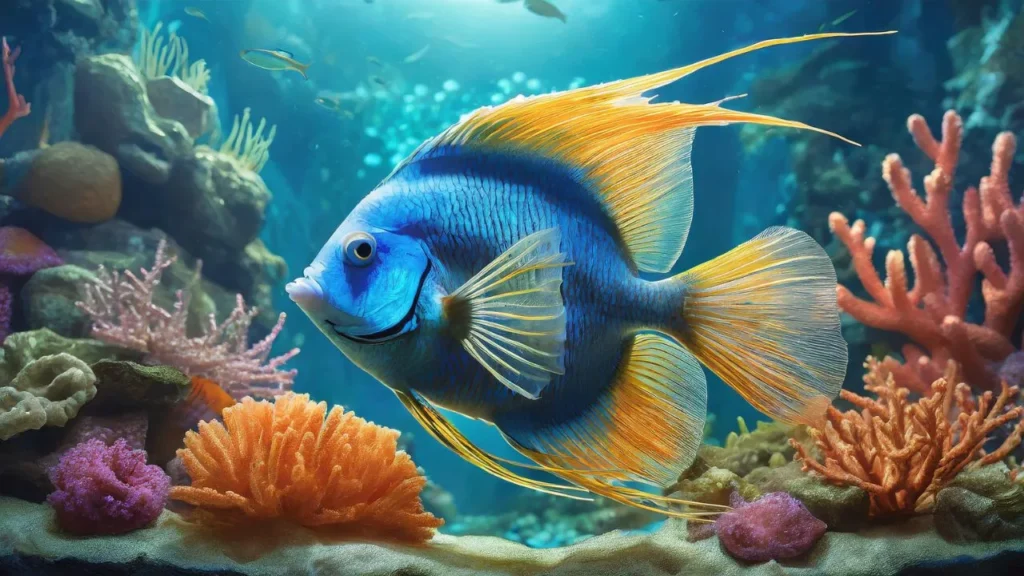
How Big Does Angelfish Get? This is a question that captures the curiosity of many aquarium enthusiasts and fish keepers around the globe. Angelfish, with their majestic fins and vibrant colors, are among the most popular inhabitants of both freshwater and saltwater aquariums. Yet, despite their popularity, there’s a fascinating spectrum of growth and size variations that many are unaware of.
In this blog post, we will dive deep into the ultimate angelfish size chart, exploring the dimensions how big does angelfish get in aquarium, smallest angelfish freshwater and largest angelfish freshwater. Whether you’re a seasoned aquarist or a budding fish hobbyist, understanding how big your angelfish can get is crucial for providing the best care and ensuring a healthy, thriving aquatic environment for these stunning creatures.
How Big Does Angelfish Get on Average?
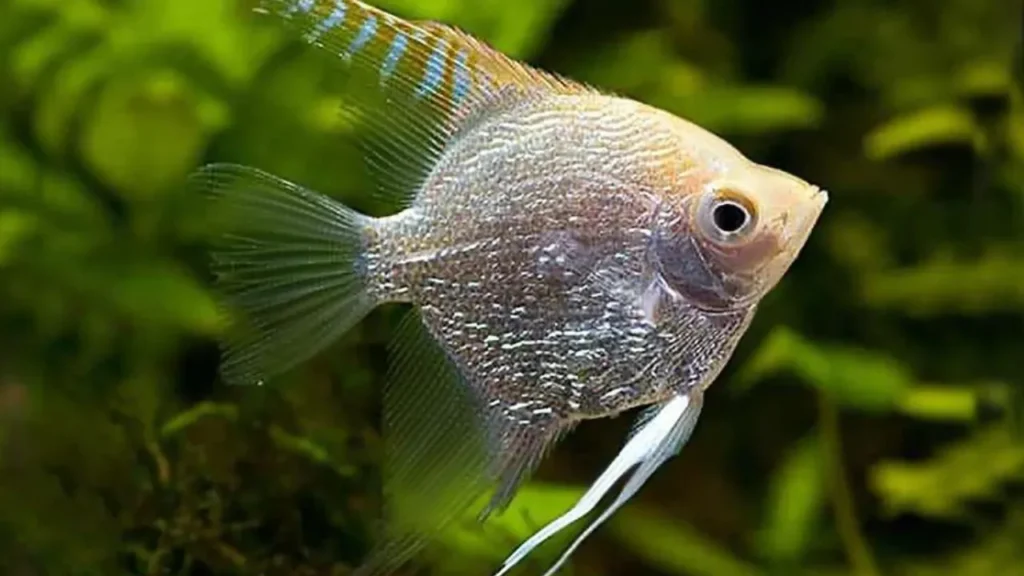
There are a few different types of freshwater angelfish, with sizes ranging from 3 inches to over 12 inches long when fully grown. Here’s a quick overview of the most common varieties and their average adult sizes:
Common Angelfish
The common angelfish (Pterophyllum scalare) is the most popular variety found in home aquariums. These fish typically reach between 5-7 inches long when fully grown.
Altum Angelfish
Altum angelfish (Pterophyllum altum) are larger than common angelfish, often growing to 10-12 inches in length. They are found in the wild and not bred as frequently in captivity.
Leopold Angelfish
Leopold angelfish (Pterophyllum leopoldi) are smaller, growing to around 3 inches as adults. They are one of the few dwarf cichlid species.
Marine Angelfish
Saltwater marine angelfish come in many vivid color variations and can grow quite large, sometimes exceeding 18 inches long. Popular marine varieties include the queen angelfish, emperor angelfish, and French angelfish.
So the answer to how big does angelfish get is, As you can see above, angelfish sizes can vary significantly depending on the specific type. The most common freshwater varieties kept in home aquariums reach between 5-10 inches long when fully grown.
How Big Does Angelfish Get in Aquarium?
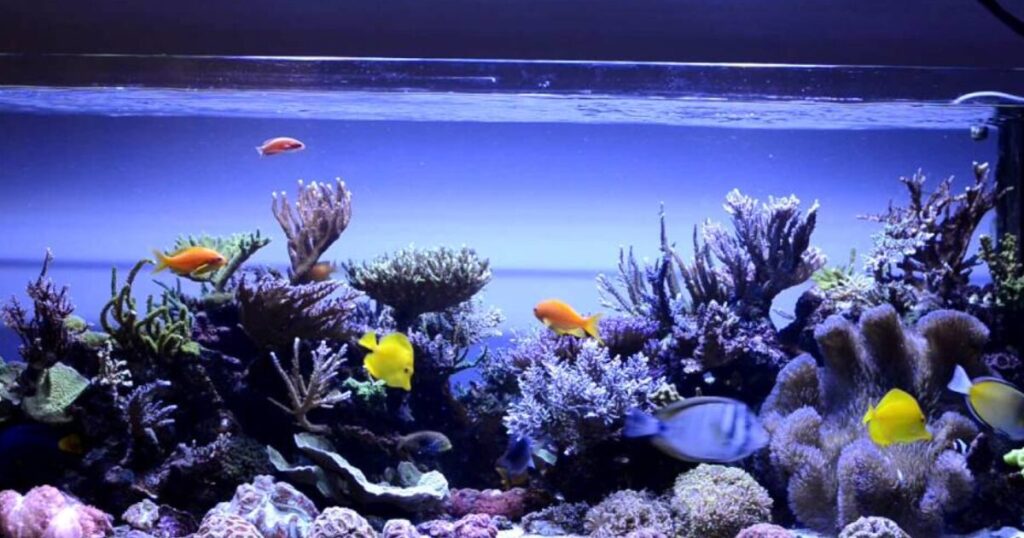
The most common variety of angelfish kept in home freshwater aquariums is Pterophyllum scalare, also known as the common or silver angelfish. This is the species that has been selectively bred over decades to produce the many color variations found in fish stores, including black, gold, marble, koi, albino, and more.
In aquarium settings, common angelfish typically reach between 5-7 inches (12-18 cm) in length when fully grown. However, size can vary slightly depending on factors like genetics, diet, and care.
Some breeds have been selectively bred to enhance certain desired traits like longer finnage, as seen in veil and lace angelfish. These varieties may fall on the upper end of the size range.
While wild common angelfish in the Amazon River can potentially grow even larger at 8-10 inches, this maximum size is rarely achieved in home aquariums. Captive bred angelfish lack the same genetic diversity and optimized environmental conditions.
Regardless of color morph, most common angelfish raised in average home aquarium conditions can be expected to mature in the 5-7 inch size range given proper care, nutrition, tank size, and water quality.
With their tall, laterally compressed bodies, mature angelfish often appear much larger than their length would indicate. Their height from the bottom of the body to the top of the dorsal fin is typically 60-80% of their length. So a 5 inch angelfish may measure 8 inches tall!
Understanding how big does angelfish get in aquarium will help in guide to choices on tank size, tank mates, and other aspects of angelfish care. While they start off small, allowing room for growth is key for these cichlids to thrive.
Freshwater Angelfish Size Dynamics
Freshwater angelfish come in many color variations. But what about sizes, what is the largest angelfish freshwater and smallest angelfish freshwater? Let’s find out!
Largest Angelfish Freshwater
The largest angelfish freshwater found is the altum angelfish (Pterophyllum altum). This majestic fish inhabits the Amazon river basin and tributaries, favoring blackwater rivers. Altum angelfish commonly reach lengths of 10-12 inches in the wild. They have elongated bodies and flowing fins giving them a truly angelic appearance. Unfortunately altum angelfish are challenging to keep in captivity, requiring highly specialized care to replicate their natural environment. But with pristine water conditions, these freshwater giants can grow nearly a foot long in home aquariums.
Smallest Angelfish Freshwater
On the other end, the dwarf or pygmy angelfish (Pterophyllum leopoldi) is the smallest angelfish freshwater. As their name suggests, Leopold’s angelfish reach a diminutive maximum length of only 3 inches. Their tiny size and peaceful temperament makes them suitable for nano community aquariums. However, they can be aggressive toward each other, especially during spawning. Leopold’s angelfish are found sporadically throughout the Amazon basin, favoring heavily vegetated side channels and flooded forests. Their small stature, striking stripes, and orange fins make them a stunning addition to planted aquariums.
Also Read: Types Of Angelfish With Picture..
Saltwater Angelfish Size Insights
Like Freshwater saltwater species also have size differentiate. So lets distinguish between largest saltwater angelfish and smallest saltwater angelfish below:
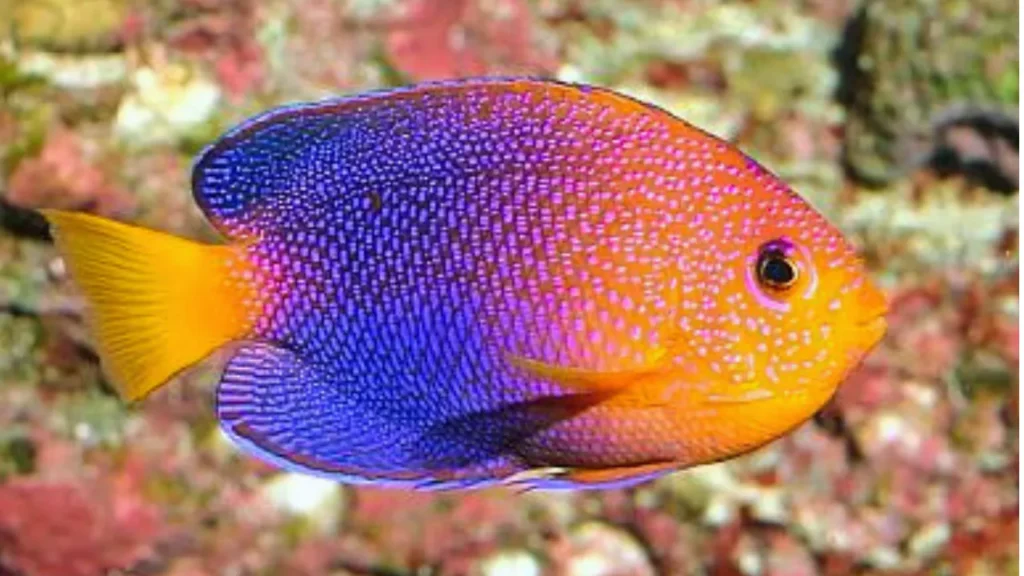
Largest Saltwater Angelfish
Of the marine angelfish species, the emperor angelfish (Pomacanthus imperator) considered to be the largest saltwater angelfish. These brightly colored fish are found on coral reefs of the Indo-Pacific region. Emperor angelfish commonly achieve lengths exceeding 16 inches in the wild. Their deep flattened body allows them to hide in coral crevices. Juveniles have dramatic concentric blue and white rings. As adults, they transition to a dominant blue and yellow horizontal stripe pattern. Aside from their immense size, emperor angelfish are prized for their longevity, often living over 10 years in home saltwater aquariums.
Smallest Angelfish Saltwater
Pygmy angelfish belong to the Centropyge genus and inhabit coral reefs worldwide which we can say the smallest saltwater angelfish. Most pygmy varieties max out around 4 inches long. The African pygmy angelfish (Centropyge acanthops) is one of the smallest, shining in a brilliant lemon hue. The equally tiny Multibar angelfish (Paracentropyge multifasciata) sports electric blue stripes. The diminutive Flameback angelfish (Centropyge acanthops) has a fiery orange-red body. Despite their small size, pygmy angelfish have oversized personalities and add a pop of color to reef tanks. Advanced care is required to meet their needs for pristine water and specialized diets in captivity. But their beauty and animation more than make up for the extra effort.
Marine angelfish growth also varies greatly based on species. Providing for their individual needs is key for both large and small saltwater varieties.
Also Read: Saltwater angelfish Species..
How Long Does It Take Angelfish to Grow Full Size?
Now that we’ve explored maximum sizes, how long does it take them to get there? Here are the general growth timelines:
Freshwater Angelfish
As we learned earlier, freshwater angelfish growth happens quickly in the first 6 months, then slows after maturity. Most reach max size within 12 months. Larger species like altums take closer to 18 months.
Saltwater Angelfish
Marine angelfish grow at varying paces depending on species. Smaller ones like the coral beauty angelfish reach 4 inches within 12 months. Larger emperor and queen angelfish take 2+ years to max out.
No matter which type of angelfish you choose, be sure to provide optimal nutrition and care from a young age to ensure they reach their full genetic potential.
Angelfish Size Chart: Species Growth Guide
To easily compare and understand how big does angelfish get in aquarium, you can refer to this following angelfish size chart covering popular freshwater and saltwater species:
| Type of Angelfish | Average Adult Size | Time to Max Size |
|---|---|---|
| Common Angelfish | 5-7 inches | 12 months |
| Altum Angelfish | 10-12 inches | 18 months |
| Leopold Angelfish | 3 inches | 12 months |
| Emperor Angelfish | 16 inches | 24+ months |
| Queen Angelfish | 18 inches | 24+ months |
| Pygmy Angel | Under 4 inches | 12 months |
| Flame Angelfish | 4 inches | 12 months |
| Potter’s Angelfish | 5 inches | 12 months |
| Koi Angelfish | 6-8 inches | 12 months |
| Dwarf Angelfish | 4 inches | 12 months |
| Lemonpeel Angelfish | 6 inches | 12 months |
| Pygmy Cherub Angelfish | 3 inches | 12 months |
| Koran Angelfish | 15 inches | 24 months |
Use this handy angelfish size chart as a quick reference tool for species profiles and growth timelines.
Angelfish Fry Growth Chart
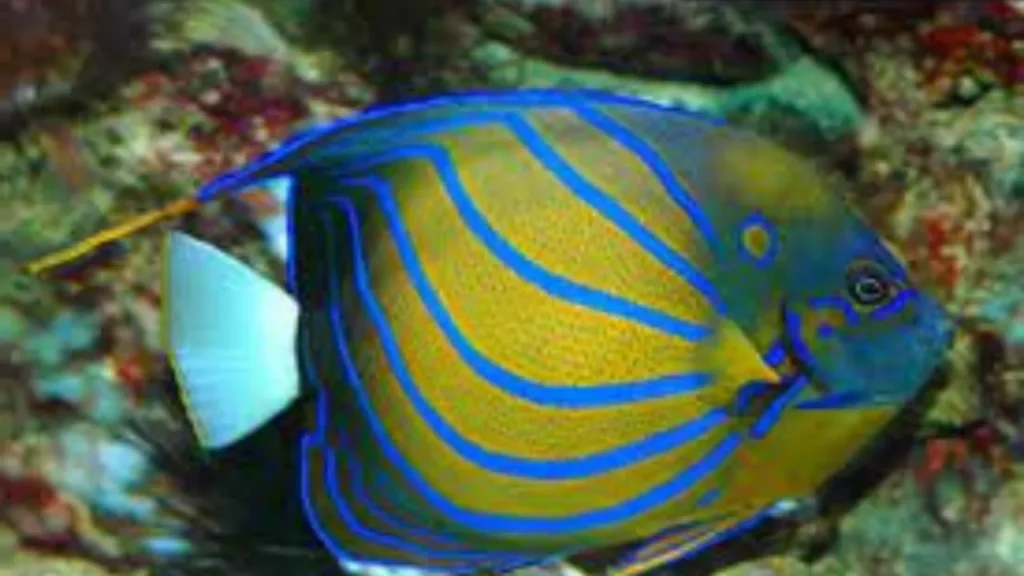
Juvenile angelfish size chart or fry growth chart can vary based on factors like diet, water quality, genetics, and more. But here’s a general timeline of what to expect:
- 0-3 months: Angelfish fry hatch tiny, less than 0.5 inches long. With proper care, they can grow to 1-2 inches in their first few months of life.
- 3-6 months: Rapid juvenile growth continues, with most angelfish reaching 3-4 inches by 6 months old.
- 6-12 months: Growth begins to slow after 6 months but continues at a steady pace. Most varieties will achieve full adult size within their first year, though some of the larger marine species may take closer to 18 months.
- 1+ years: After the first year, angelfish are considered fully mature. Some varieties may fill out slightly in their second year, but growth is minimal after age one.
As you can see, angelfish grow quickly as juveniles, gaining several inches in just their first 6 months. But after reaching adulthood, their size remains fairly constant throughout their lifespan.
Tracking growth milestones with an angelfish fry chart allows assessing if supplementation or interventions may be needed to support proper development.
Read More: Angelfish Fry Care Guide..
Factors Influencing Angelfish Growth
While the above timeline provides a general overview on ” How big does angelfish get”, several factors can cause individual angelfish growth rates to vary. Here are some of the key elements that affect their ultimate size:
Genetics
Like other animals, genetics play a major role in angelfish size. Some varieties are predisposed to growing larger, while others tend to stay smaller. Selective breeding programs allow breeders to enhance desired genetic traits.
Diet & Nutrition
Providing a nutritious diet with ample protein is crucial for angelfish to reach their full growth potential. Feeding a variety of foods including live, frozen, freeze-dried options ensures they get all required nutrients.
Read More: Angelfish Diet..
Water Quality
Poor water quality can lead to disease and stress, stunting an angelfish’s growth. Performing regular water changes, testing parameters, and filtration helps keep water clean.
Tank Size
Angelfish limited by small tank sizes may not grow as large. Allowing ample swimming room promotes growth.
Tank Mates
Aggressive tank mates that bully angelfish can inhibit their growth. Choosing peaceful companions reduces stress.
Read More: 15 Best Angelfish Tank Mates..
Growth Phases
Using angelfish growth charts helps track their development from fry to adult. Understanding normal growth phases allows recognition of potential issues.
By optimizing these factors, you can help your angelfish thrive and maximize their genetic size potential.
Maximizing Angelfish Growth Potential
Want your angelfish to become a show stopping giant? Here are some tips:
- Select species with genetics for large size
- Feed a high protein, varied diet including live, frozen, freeze-dried foods
- House juveniles in minimum 20 gallon tanks, increasing to 55+ gallons for adults
- Maintain pristine water quality via testing, water changes, filtration
- Avoid aggressive tank mates that may bully or nip fins
- Ensure adequate tank decor like plants and caves for hiding
Giving your angelfish the best possible start in a spacious, nurturing environment will allow them to achieve their full genetic growth potential.
Key Takeaways on “How Big Does Angelfish Get“
To wrap up the topic “how big does angelfish get”, let’s review the key points on angelfish growth covered in this guide:
- Genetics, diet, water, tank size, and tank mates all impact maximum size
- Freshwater species reach 5-12 inches; marine species span 3-18 inches
- Rapid juvenile growth happens in first 6 months, then slows around maturity
- Use angelfish growth charts to track developmental stages
- Allow 12-24+ months to reach full size depending on species
- Optimizing conditions promotes the largest possible size
We hope this beginner’s guide has helped explain angelfish growth dynamics and size potential. Please let us know if you have any other questions!
FAQs
How big does a coral beauty angelfish get?
The coral beauty angelfish (Centropyge bispinosa) is a popular dwarf marine species that reaches a maximum size of 4 inches as an adult. A coral beauty angelfish can achieve its full 4 inch length within 12-18 months. Its petite size makes it suitable for nano reef aquariums.
How big does a flame angelfish get?
Flame angelfish grow to around 4 inches in length at maturity. Flame angelfish can reach their maximum of 4 inches within the first year. Their small size allows keeping them in nano reef tanks.
How big does a freshwater angelfish get?
Freshwater angelfish typically reach between 5-7 inches long as adults. Their growth rate is most rapid as juveniles, gaining several inches in the first 6 months.

